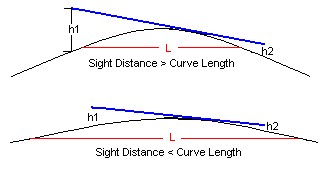



|

Crest Vertical Curves
Crest vertical curves are curves that connect inclined sections of
roadway, forming a crest, and they are relatively easy to design. As you know from
the module entitled ‘Vertical Curves,’ we only need to find an appropriate
length for the curve that will accommodate the correct sight distance. The stopping
sight distance is usually the controlling sight distance, but the decision sight distance
or even the passing sight distance could be used if desired. The passing sight distance is
rarely ever used as the design sight distance, because it demands long, gentle curvatures
that are expensive and difficult to construct.
The sight distance and the length of the curve can be related to each other in one of
two ways. The first possibility is that the sight distance is less than the length of
the curve. Alternatively, the length of the curve could be less than the sight
distance. See figure 1.0.

Figure 1.0: Sight Distance Possibilities
In any case, there are equations that relate these
two parameters to the change in grade for both possible conditions. The designer must
double-check that the equation that is used agrees with its own assumptions. For
example, if the equation that is based on sight distances that are less than the curve
length produces a curve length that is less than the sight distance, you know that the
result is invalid. The equations that are normally used to calculate the lengths of
crest vertical curves are given below.
If S > L then

If S < L then

Where:
L = Length of the crest vertical curve (ft)
S = Sight distance (ft)
A = The change in grades ( |G2-G1| as a percent)
h1 = Height of the driver's eyes above the ground (ft)
h2 = Height of the object above the roadway (ft)
The heights in the calculations above should be those that correspond to the sight
distance of interest. For the stopping sight distance, h1 = 3.5 ft and h2 = 0.5 ft.
For the passing sight distance, h1 = 3.5 ft and h2 = 4.25 ft.
While the sight distance has been portrayed as the only parameter that affects the
design of vertical curves, this isn't entirely true. Vertical curves should also be
comfortable for the driver, aesthetically pleasing, safe, and capable of facilitating
proper drainage. In the special case of crest vertical curves, it just so happens
that a curve designed with adequate sight distances in mind is usually aesthetically
pleasing and comfortable for the driver. In addition, drainage is rarely a special concern
for crest vertical curves.
|